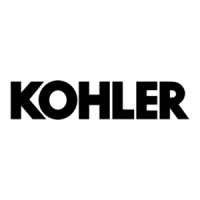
Do you have a question about the Kohler 13EFOZ and is the answer not in the manual?
| Model | 13EFOZ |
|---|---|
| Type | Portable Generator |
| AC Maximum Output (Watts) | 13000 |
| Fuel Type | Gasoline |
| Starting System | Electric Start |
| AC Output | 120/240V |
| DC Output | 12V |
| Engine Type | 4-Cycle, OHV, Air-Cooled |
Covers risks of unintended start-up and battery acid/gas, including safety procedures.
Details fire risks from fuel/sparks and carbon monoxide poisoning from exhaust.
Warns about noise, electrical shock, and hot component dangers during operation.
Addresses risks from rotating parts and safe lifting procedures for equipment.
Provides contact details for sales, service, and product information.
Explains what the manual covers and how to use it for effective operation.
Lists generator models covered by the manual and their specifications.
Specifics on engine manufacturer, cylinders, bore, displacement, and oil.
Covers fuel recommendations, pump pressure, and inlet types.
Details coolant type, capacity, thermostat, and pressure ratings.
Provides exciter field, stator resistance, and output voltage specifications.
Illustrates typical service views with component identification for reference.
Instructions for scheduling maintenance and general operational notes.
Details engine oil selection based on SAE grade and API classification.
Covers air silencer cleaning, exhaust inspection, mixing elbow, and turbocharger.
Explains typical fuel tank arrangements and availability with low fuel.
Provides instructions for filter replacement and fuel system air removal.
Details procedures for testing the fuel pump and adjusting the governor.
Describes the heat exchanger cooling system components.
Instructions for checking, filling, and cleaning the cooling system.
Guides on inspecting and replacing the seawater pump impeller.
Details the procedure to inspect the siphon break system.
Identifies internal components and describes sequence of operation.
Covers Low Oil Pressure, High Water/Exhaust Temperature, and Overspeed shutdowns.
Explains testing of controller board components and LED indicators.
Step-by-step diagnostic guides for controller circuit board issues.
Emphasizes essential safety rules before performing generator tests.
Diagnosing no/low output and testing the voltage regulator.
Procedures for testing key generator internal components.
Checking hourmeter, stator windings, switches, and relays with a multimeter.
Guides troubleshooting of remote panel switches, gauges, and senders.
Details the step-by-step procedure for safely disassembling the generator set.
Provides instructions for correctly reassembling the generator set after service.
Shows wiring diagrams for manual ship-to-shore transfer switches.
Illustrates various remote start panel configurations.
Detailed schematics for 4-lead and 12-lead generator set connections.